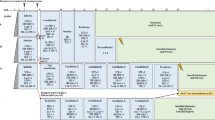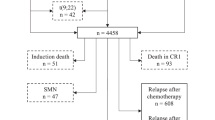Abstract
With improved contemporary therapy, we reassess long-term outcome in patients completing treatment for childhood acute lymphoblastic leukemia (ALL) to determine when cure can be declared with a high degree of confidence. In six successive clinical trials between 1984 and 2007, 1291 (84.5%) patients completed all therapies in continuous complete remission. The post-therapy cumulative risk of relapse or development of a second neoplasm and the event-free survival rate and overall survival were analyzed according to the presenting features and the three treatment periods defined by relative outcome. Over the three treatment periods, there has been progressive increase in the rate of event-free survival (65.2% vs 74.8% vs 85.1% (P<0.001)) and overall survival (76.5% vs 81.1% vs 91.7% (P<0.001)) at 10 years. The most important predictor of outcome after completion of therapy was the type of treatment. In the most recent treatment period, which omitted the use of prophylactic cranial irradiation, the post-treatment cumulative risk of relapse was 6.4%, death in remission 1.5% and development of a second neoplasm 2.3% at 10 years, with all relapses except one occurring within 4 years of therapy. None of the 106 patients with the t(9;22)/BCR-ABL1, t(1;19)/TCF3-PBX1 or t(4;11)/MLL-AFF1 had relapsed after 2 years from completion of therapy. These findings demonstrate that with contemporary effective therapy that excludes cranial irradiation, approximately 6% of children with ALL may relapse after completion of treatment, and those who remain in remission at 4 years post treatment may be considered cured (that is, less than 1% chance of relapse).
This is a preview of subscription content, access via your institution
Access options
Subscribe to this journal
Receive 12 print issues and online access
$259.00 per year
only $21.58 per issue
Buy this article
- Purchase on Springer Link
- Instant access to full article PDF
Prices may be subject to local taxes which are calculated during checkout



Similar content being viewed by others
References
Pui CH, Cheng C, Leung W, Rai SN, Rivera GK, Sandlund JT et al. Extended follow-up of long-term survivors of childhood acute lymphoblastic leukemia. N Engl J Med 2003; 349: 640–649.
Vora A, Frost L, Goodeve A, Wilson G, Ireland RM, Lilleyman J et al. Late relapsing childhood lymphoblastic leukemia. Blood 1998; 92: 2334–2337.
Maule M, Scélo G, Pastore G, Brennan P, Hemminki K, Tracey E et al. Risk of second malignant neoplasms after childhood leukemia and lymphoma: an international study. J Natl Cancer Inst 2007; 99: 790–800.
Mody R, Li S, Dover DC, Sallan S, Leisenring W, Oeffinger KC et al. Twenty-five-year follow-up among survivors of childhood acute lymphoblastic leukemia: a report from the Childhood Cancer Survivor Study. Blood 2008; 111: 5515–5523.
Taylor AJ, Little MP, Winter DL, Sugden E, Ellison DW, Stiller CA et al. Population-based risks of CNS tumors in survivors of childhood cancer: the British Childhood Cancer Survivor Study. J Clin Oncol 2010; 28: 5287–5293.
Pui CH, Mullighan CG, Evans WE, Relling MV . Pediatric acute lymphoblastic leukemia: where are we going and how do we get there? Blood 2012; 120: 1165–1174.
Pui CH, Campana D, Pei D, Bowman WP, Sandlund JT, Kaste SC et al. Treating childhood acute lymphoblastic leukemia without cranial irradiation. N Engl J Med 2009; 360: 2730–2741.
Hunger SP, Lu X, Devidas M, Camitta BM, Gaynon PS, Winick NJ et al. Improved survival for children and adolescents with acute lymphoblastic leukemia between 1990 and 2005: a report from the children's oncology group. J Clin Oncol 2012; 30: 1663–1669.
Vrooman LM, Stevenson KE, Supko J, O'Brien J, Dahlberg SE, Asselin BL et al. Postinduction dexamethasone and individualized dosing of Escherichia coli L-asparaginase each improve outcome of children and adolescents with newly diagnosed acute lymphoblastic leukemia: results from a randomized study–Dana-Farber Cancer Institute ALL Consortium Protocol 00-01. J Clin Oncol 2013; 31: 1202–1210.
Vora A, Goulden N, Wade R, Mitchell C, Hancock J, Hough R et al. Treatment reduction for children and young adults with low-risk acute lymphoblastic leukaemia defined by minimal residual disease (UKALL 2003): a randomised controlled trial. Lancet Oncol 2013; 14: 199–209.
Rivera GK, Raimondi SC, Hancock ML, Behm FG, Pui CH, Abromowitch M et al. Improved outcome in childhood acute lymphoblastic leukaemia with reinforced early treatment and rotational combination chemotherapy. Lancet 1991; 337: 61–66.
Evans WE, Relling MV, Rodman JH, Crom WR, Boyett JM, Pui CH et al. Conventional compared with individualized chemotherapy for childhood acute lymphoblastic leukemia. N Engl J Med 1998; 338: 499–505.
Pui CH, Mahmoud HH, Rivera GK, Hancock ML, Sandlund JT, Behm FG et al. Early intensification of intrathecal chemotherapy virtually eliminates central nervous system relapse in children with acute lymphoblastic leukemia. Blood 1998; 92: 411–415.
Pui CH, Sandlund JT, Pei D, Campana D, Rivera GK, Ribeiro RC et al. Improved outcome for children with acute lymphoblastic leukemia: results of Total Therapy Study XIIIB at St Jude Children's Research Hospital. Blood 2004; 104: 2690–2696.
Pui CH, Pei D, Sandlund JT, Ribeiro RC, Rubnitz JE, Raimondi SC et al. Long-term results of St Jude Total Therapy Studies 11, 12, 13A, 13B, and 14 for childhood acute lymphoblastic leukemia. Leukemia 2010; 24: 371–382.
Kalbfleisch JD, Prentice RL . The Statistical Analysis of Failure Time Data 2nd edn. Wiley: New York, NY, 2002; p 247.
Choudhury JB . Non-parametric confidence interval estimation for competing risk analysis: application of to contraceptive data. Stat Med 2002; 21: 1129–1144.
Hochberg Y, Benjamini Y . More powerful procedures for multiple significance testing. Stat Med 1990; 9: 811–818.
Schmiegelow K, Al-Modhwahi I, Andersen MK, Behrendtz M, Forestier E, Hasle H et al. Methotrexate/6-mercaptopurine maintenance therapy influences the risk of a second malignant neoplasm after childhood acute lymphoblastic leukemia: results from the NOPHO ALL-92 study. Blood 2009; 113: 6077–6084.
Schrappe M, Reiter A, Ludwig WD, Harbott J, Zimmermann M, Hiddemann W et al. Improved outcome in childhood acute lymphoblastic leukemia despite reduced use of anthracyclines and cranial radiotherapy: results of trial ALL-BFM 90. Blood 2000; 95: 3310–3322.
Li A, Zhou J, Zuckerman D, Rue M, Dalton V, Lyons C et al. Sequence analysis of clonal immunoglobulin and T-cell receptor gene rearrangements in children with acute lymphoblastic leukemia at diagnosis and at relapse: implications for pathogenesis and for the clinical utility of PCR-based methods of minimal residual disease detection. Blood 2003; 102: 4520–4526.
van Vlierberghe P, Meijerink JP, Lee C, Ferrando AA, Look AT, van Wering ER et al. A new recurrent 9q34 duplication in pediatric T-cell acute lymphoblastic leukemia. Leukemia 2006; 20: 1245–1253.
Ford AM, Fasching K, Panzer-Grümayer ER, Koenig M, Haas OA, Greaves MF et al. Origins of "late" relapse in childhood acute lymphoblastic leukemia with TEL-AML1 fusion genes. Blood 2001; 98: 558–564.
Konrad M, Metzler M, Panzer S, Ostreicher I, Peham M, Repp R et al. Late relapses evolve from slow-responding subclones in t(12;21)-positive acute lymphoblastic leukemia: evidence for the persistence of a preleukemic clone. Blood 2003; 101: 3635–3640.
Mullighan CG, Phillips LA, Su X, Ma J, Miller CB, Shurtleff SA et al. Genomic analysis of the clonal origins of relapsed acute lymphoblastic leukemia. Science 2008; 322: 1377–1380.
Zuna J, Cave H, Eckert C, Szczepanski T, Meyer C, Mejstrikova E et al. Childhood secondary ALL after ALL treatment. Leukemia 2007; 21: 1431–1435.
Szczepanski T, Van der Velden VH, Waanders E, Kuiper RP, Van Vlierberghe P, Gruhn B et al. Late recurrence of childhood T-cell acute lymphoblastic leukemia frequently represents a second leukemia rather than a relapse: first evidence for genetic predisposition. J Clin Oncol 2011; 29: 1643–1649.
Schultz KR, Bowman WP, Aledo A, Slayton WB, Sather H, Devidas M et al. Improved early event-free survival with imatinib in Philadelphia chromosome-positive acute lymphoblastic leukemia: a children’s oncology group study. J Clin Oncol 2009; 27: 5175–5181.
Biondi A, Schrappe M, De LP, Castor A, Lucchini G, Gandemer V et al. Imatinib after induction for treatment of children and adolescents with Philadelphia-chromosome-positive acute lymphoblastic leukaemia (EsPhALL): a randomised, open-label, intergroup study. Lancet Oncol 2012; 13: 936–945.
van Dongen JJ, Seriu T, Panzer-Grümayer ER, Panzer-Grümayer ER, Biondi A, Pongers-Willemse MJ et al. Prognostic value of minimal residual disease in acute lymphoblastic leukaemia in childhood. Lancet 1998; 352: 1731–1738.
Coustan-Smith E, Behm FG, Sanchez J, Boyett JM, Hancock ML, Raimondi SC et al. Immunological detection of minimal residual disease in children with acute lymphoblastic leukaemia. Lancet 1998; 351: 550–554.
Borowitz MJ, Devidas M, Hunger SP, Bowman WP, Carroll AJ, Carroll WL et al. Clinical significance of minimal residual disease in childhood acute lymphoblastic leukemia and its relationship to other prognostic factors: a Children’s Oncology Group study. Blood 2008; 111: 5477–5485.
Conter V, Bartram CR, Valsecchi MG, Schrauder A, Panzer-Grümayer R, Möricke A et al. Molecular response to treatment redefines all prognostic factors in children and adolescents with B-cell precursor acute lymphoblastic leukemia: results in 3184 patients of the AIEOP-BFM ALL 2000 study. Blood 2010; 115: 3206–3214.
Stow P, Key L, Chen X, Pan Q, Neale GA, Coustan-Smith E et al. Clinical significance of low levels of minimal residual disease at the end of remission induction therapy in childhood acute lymphoblastic leukemia. Blood 2010; 115: 4657–4663.
Schrappe M, Valsecchi MG, Bartram CR, Schrauder A, Panzer-Grümayer R, Möricke A et al. Late MRD response determines relapse risk overall and in subsets of childhood T-cell ALL: results of the AIEOP-BFM-ALL 2000 study. Blood 2011; 118: 2077–2084.
Pui CH, Pei D, Sandlund JT, Campana D, Ribeiro RC, Razzouk BI et al. Risk of adverse events after completion of therapy for childhood acute lymphoblastic leukemia. J Clin Oncol 2005; 23: 7936–7941.
Forestier E, Heyman M, Andersen MK, Autio K, Blennow E, Borgström G et al. Outcome of ETV6/RUNX1-positive childhood acute lymphoblastic leukaemia in the NOPHO-ALL-1992 protocol: frequent late relapses but good overall survival. Br J Haematol 2008; 140: 665–672.
Wakefield CE, McLoone JK, Butow P, Lenthen K, Cohn RJ . Parental adjustment to the completion of their child’s cancer treatment. Pediatr Blood Cancer 2011; 56: 524–531.
Park ER, Li FP, Liu Y, Emmons KM, Ablin A, Robison LL et al. Health insurance coverage in survivors of childhood cancer: the Childhood Cancer Survivor Study. J Clin Oncol 2005; 23: 9187–9197.
Ginsberg JP . Health insurance for survivors of childhood cancer: a pre-existing problem. Pediatr Blood Cancer 2009; 53: 928–930.
Conklin HM, Krull KR, Reddick WE, Pei D, Cheng C, Pui CH . Cognitive outcomes following contemporary treatment without cranial irradiation for childhood acute lymphoblastic leukemia. J Natl Cancer Inst 2012; 104: 1386–1395.
Acknowledgements
This work was funded in part by the NCI grant CA21765, CA36401 and U01 GM92666, and the American Lebanese and Syrian Associated Charities (ALSAC).
Author information
Authors and Affiliations
Corresponding author
Ethics declarations
Competing interests
The authors declare no conflict of interest.
Additional information
Author Contributions
CHP, CC, DP and WHL designed, analyzed and interpreted the study. DC, SCR and ECS performed the laboratory research. CHP, DC, WHL and WEE wrote the manuscript. CHP, JTS, WPB, MMH, RCR, SJ, SCH, DB, HI, JER, MLM and TAG provided clinical data. All authors critically reviewed the manuscript and gave their final approval.
Supplementary Information accompanies this paper on the Leukemia website
Supplementary information
Rights and permissions
About this article
Cite this article
Pui, C., Pei, D., Campana, D. et al. A revised definition for cure of childhood acute lymphoblastic leukemia. Leukemia 28, 2336–2343 (2014). https://doi.org/10.1038/leu.2014.142
Received:
Accepted:
Published:
Issue Date:
DOI: https://doi.org/10.1038/leu.2014.142
This article is cited by
-
Targeting NOTCH1 in combination with antimetabolite drugs prolongs life span in relapsed pediatric and adult T-acute lymphoblastic leukemia xenografts
Experimental Hematology & Oncology (2023)
-
Integrative genomic analysis of childhood acute lymphoblastic leukaemia lacking a genetic biomarker in the UKALL2003 clinical trial
Leukemia (2023)
-
Causes of death and treatment-related mortality in newly diagnosed childhood acute lymphoblastic leukemia treatment with Chinese Children’s Cancer Group study ALL-2015
Annals of Hematology (2023)
-
Semisynthetic aurones A14 protects against T-cell acute lymphoblastic leukemia via suppressing proliferation and inducing cell cycle arrest with apoptosis
Chinese Medicine (2022)
-
The role of minimal residual disease in specific subtypes of pediatric acute lymphoblastic leukemia
International Journal of Hematology (2021)



